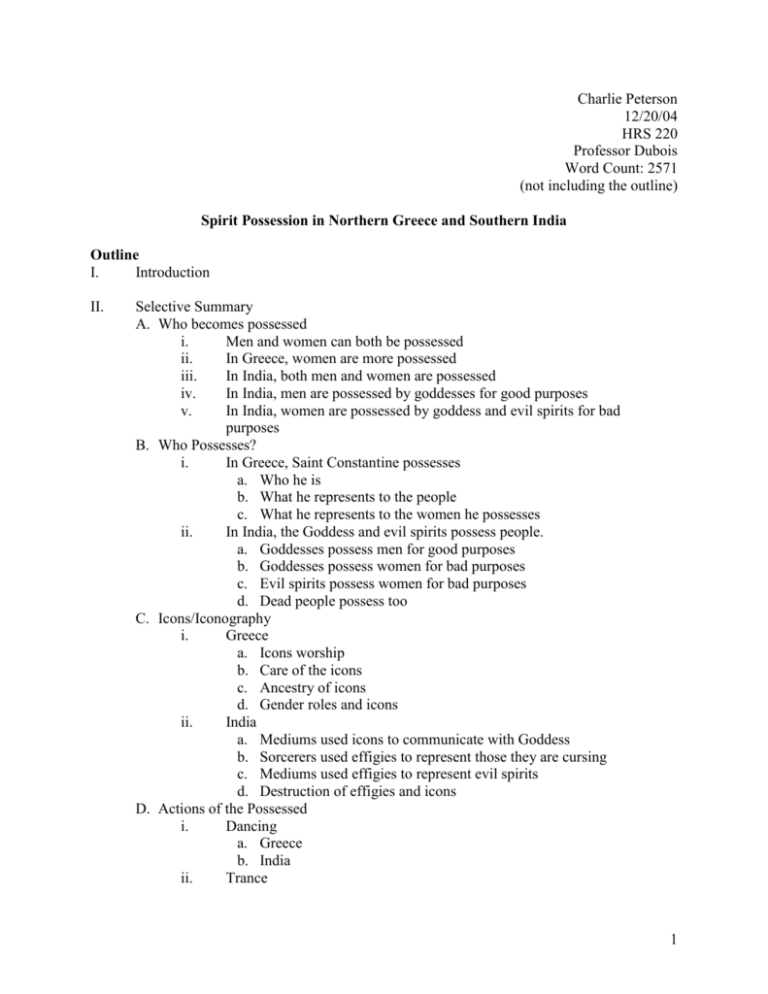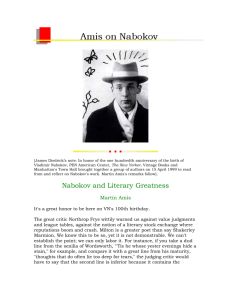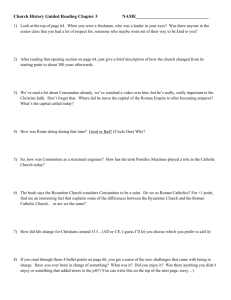Who Possesses - California State University, Sacramento
advertisement

Charlie Peterson 12/20/04 HRS 220 Professor Dubois Word Count: 2571 (not including the outline) Spirit Possession in Northern Greece and Southern India Outline I. Introduction II. Selective Summary A. Who becomes possessed i. Men and women can both be possessed ii. In Greece, women are more possessed iii. In India, both men and women are possessed iv. In India, men are possessed by goddesses for good purposes v. In India, women are possessed by goddess and evil spirits for bad purposes B. Who Possesses? i. In Greece, Saint Constantine possesses a. Who he is b. What he represents to the people c. What he represents to the women he possesses ii. In India, the Goddess and evil spirits possess people. a. Goddesses possess men for good purposes b. Goddesses possess women for bad purposes c. Evil spirits possess women for bad purposes d. Dead people possess too C. Icons/Iconography i. Greece a. Icons worship b. Care of the icons c. Ancestry of icons d. Gender roles and icons ii. India a. Mediums used icons to communicate with Goddess b. Sorcerers used effigies to represent those they are cursing c. Mediums used effigies to represent evil spirits d. Destruction of effigies and icons D. Actions of the Possessed i. Dancing a. Greece b. India ii. Trance 1 III. Evaluation A. The sources themselves (primary and secondary) B. Did they interview enough people C. Did they perform a comprehensive background history D. Is there a contemporary history to situate the sources E. Is there enough historical information – is this even relevant to the studies? IV. Wider Relevance A. Modern religious mysticism B. Gender Roles Reading Analysis I. Introduction Danforth’s Firewalking and Religious Healing and Nabokov’s Religion Against the Self are anthropological analyses of religious cultures that prominently feature spirit possession. Danforth presents a religion called the Anastenaria that focus on the worship of the healing powers of Saint Constantine. Nabokov presents the Tamil tradition based in the Tamilnadu region of southern India where individuals worship the healing powers of various Hindu goddesses. In northern Greece, the traditions of the Anastenaria are upheld through dancing and firewalking, icon worship and spirit possession. The Tamils are a mixed group consisting of mediums who channel the spirits of the goddesses, and victims who are possessed by demons. It is in the context of these two traditions that I argue that spirit possession plays a major role in the religious lives of the modern societies of northern Greece and in southern India. II. Selective Summary Who Becomes Possessed In the cultures of the Anastenaria of northern Greece and the Tamil people of southern India, spirit possession afflicted both men and women who were in need of healing. Spirit possession became an outlet for individuals who suffered from problems that could not be solved by modern methods, e.g. psychiatry, modern medicine or through a judicial system. The cases 2 presented in Danforth’s and Nabokov’s studies also tended to belong to the lower classes of their respective societies. Spirit possession of the Anastenarides was a gendered phenomenon, afflicting more women than men (Danforth 5). The possession of women by the spirit of Saint Constantine enabled these individuals to cope with physical, mental and social problems. “The relationships between people and the spirits who possess them are thus metaphors for people’s social, psychological, and physiological conditions” (60). Women gained control over their lives within a male-dominated society through the ritual possession of the Saint (101). In Nabokov’s anthropological study of the Tamil people, she presented cases where deities and evil spirits possessed men and women. People came to seek the guidance of individuals known as cāmis, who themselves were possessed by various deities (e.g. Kālī, Śakti, etc.). They did so to “discover the causes of persistent illnesses, to resolve personal problems, to be relieved of sorcery spells and possessing demons” (Nabokov 4). Spirit possession of common people was considered a problem to be remedied through the intervention of spiritually possessed cāmis. Nabokov’s study of the spiritually possessed Tamilnadu cāmis included seven men and one woman. The men initially became possessed by being penetrated by the Goddesses in the form of an illness, or the deities seduced the men with sexual prospects (28). However, the goddess Ankālaparamēcuvari selected the lone woman cāmi through the guise of an illness (115). The cāmis were recruited to serve as counselors for people who could not resolve their problems through “modern” means. Gender played an important role with regards to people who suffered from possession by malicious spirits. The majority of the cases Nabokov studied were women possessed by evil, 3 (mostly) male demons, known as pēy. Goddesses could also possess individuals for malicious intent (46). Nabokov noted that pēy were believed to be mostly spirits of young men, explaining their sexual desire to possess young women (73). Women who had marital problems were often accused of being “caught” by pēy, and forced to “rededicate themselves to cultural expectations of the ‘good wife’ (cumankali)” (72). In this sense, spirit possession was a method by which the status quo is maintained. Who Possesses In Danforth’s study of the Anastenaria, he reported that the Anastenarides believed that it was the spirit of Saint Constantine that possessed them. The Anastenarides associated Saint Constantine with Constantine the Great, the Roman Emperor who established Christianity as the official religion of the Roman Empire (Danforth 85). A reason Saint Constantine and his mother Helen (who was also canonized) are worshipped by the Anastenarides is for their historical importance regarding the origins of the sacred firewalk (85). Saint Constantine was also seen as the eponymous founder of the Anastenarides’ ancestral home of Kosti (172). The religious healing in the Anastenaria comes about from a symbiotic relationship with the spirit of Saint Constantine and an Anastenaris (84). “Saint Constantine is a powerful symbol that stands for many aspects of the psychological and social reality of the Kostilides [an ethnic title for Anastenarides]” (90). Relationships with Saint Constantine differed along gender lines. Men saw the Saint as a grandfather figure, whereas for women, Saint Constantine was a husbandly figure (87-88). The ritual dancing of the Anastenarissa symbolized the marriage to the Saint (88). Saint Constantine could also symbolize the important men in an Anastenarissa’s life (90). In Religion Against the Self, Nabokov discussed the various types of spirits who would possess the people who would later become cāmis, as well as individuals who would be 4 victimized. The goddesses involved in the spiritual possession of cāmis were Śakti, Kālī and Ankālaparamēcuvari (Nabokov 20-22). The goddesses represented a means of dealing with problems such as personal/marital problems or sickness (24). Conversely, goddesses also attacked people, usually women, by giving them the “evil eye” (46). This also occurred at moments of personal crises, or at least was perceived to be the cause of them. Pēy were usually male demons that lusted after young women (73). Demonic possession was “a culturally constituted idiom available to women for expressing and managing their personal problems” (71). Possession by familial spirits was also a common occurrence. These spirits usually possessed their relatives at moments when ceremonial protocol at festivities such as marriages or ear-piercing ceremonies had been breached (6, 131). Icons and their Importance In the book Firewalking and Religious Healing, Danforth presented the idea that icons were integral to the spirit possession rituals of the Anastenaria. The icons were believed to possess the spirit of the Saints. The icons were also thought to “possess supernatural power and the ability to perform miracles” (Danforth 72). During the Festival of Saints Constantine and Helen, the icons were danced with, and were carried across fire. During the firewalking, the icons were believed to protect the Anastenarides from being burned by the hot coals. Dancing with the icons also allowed the power of the Saint to pass on to the dancers. Furthermore, because the icons contained the spirits of the Saints, they needed to be housed properly. Icons were often placed on shelves, sometimes near windows so that the Saints could look out of a window (26). The main purpose of an Anastenaris having an icon shelf was so that there would be a place for the Saints to rest when they visited the person’s home (43). Additionally, gender influenced the treatment of icons. Women were the primary caretakers of the icons, in that they 5 were responsible getting them repainted (26), as well as washing the simadia (67). During the festivities, men could handle the icons at anytime, whereas women had to seek permission from men first (13). In the Tamil traditions of spirit possession, icons, as well as effigies were used to communicate with, and to symbolize good and evil spirits. In one instance, a medium named Nagaji ritualistically communicated with, and eventually channeled the goddess Śakti through the use of icons such as a brass pot filled with water and margosa branches (Nabokov 37). In the Tamil tradition, evil sorcerers cast their curses upon small effigies of their victims so as to hinder their victims’ reproductive, vocal or mobile capabilities (45). These effigies became a symbol of transference for negative forces. Conversely, mediums use effigies to rid people of their pēy. In ritual exorcisms, mediums made effigies of the victims, and placed items attractive to pēy in order to lure them out of the host (57). Also, mediums created effigies of the demons themselves, and performed funeral rites upon them to symbolize the death of the pēy, the culmination of the exorcism (61). Actions of the Possessed Saint Constantine’s possession of the Anastenarides’ bodies was integral to the Festival of Saints Constantine and Helen. Saint Constantine took control of the Anastenarides by forcing them to dance (Danforth 11) and ultimately to walk across fire (20). Dancing to the Anastenarides is a release of anxiety, as well as a sign of being healed by the Saint (131). The firewalk is the culmination of the festivities as well as a symbol of power and trust (131). It is from [Saint Constantine] that the Anastenarides receive the supernatural power that enables them to perform the firewalk unharmed. More importantly, however it is through the beneficent power of Saint Constantine that their own illnesses are healed. (116) 6 Through the power of Saint Constantine, the Anastenarides could overcome their problems – emotional, health related, anything. The Anastenaria is a spiritual system that provides people with the means to transform and take control of their troubled lives through spirit possession (84). Women gained control over their lives within an androcentric society through spirit possession as evidenced through dancing and firewalking. In Tamil culture, ritual dancing was a symptom of the trance-like state the spiritually possessed are in. Nabokov witnessed one ceremony where rhythmic drumming was used to entice the pēy to begin dancing (80). Dancing would mean that the spirit was responsive to the exorcism, and would soon leave the host. Both cultures share dancing as a part of the rituals, but the purposes are very different. In Tamil culture, trance-like states were indicative of spiritual possession. For instance, goddesses used the mediums as vessels to help victims with their problems caused by pēys. The mediums became the voice for the goddesses, and would dictate what to do to overcome their problems. Likewise, the victims became vessels of communication for the pēys. It was during exorcisms that the victims would enter a trance-like state, and channel the voice of the pēys. Similarly, Saint Constantine would occasionally spoke through an Anastenaris to communicate his thoughts on a particular matter. The two different cultures of the Tamils and the Anastenarides share similarities with regards to channeling supernatural powers through human hosts. III. Evaluation In their anthropological treatments of the Anastenaria and the Tamils, Danforth and Nabokov utilized a variety of primary and secondary sources. Danforth incorporated first hand narratives of spirit possession from individual Anastenarides along with a description of the rituals themselves. Likewise, Nabokov weaved together individual narratives with detailed 7 accounts of the rituals and exorcisms. The two writers also incorporated contemporary anthropological thought to analyze the events they witnessed. In his second chapter, Danforth rationalized the spiritual healing of the Anastenarides from a scientific angle. Nabokov integrated contrary theses from other anthropologists to complement her thoughts on spirit possession in southern India. Danforth and Nabokov used a great deal of space in their ethnographic treatments for narratives and first-hand accounts of the ritual practices, but they did not, in my opinion interview enough people. Danforth, by his own admission did not spend much time interviewing male Anastenarides, instead focusing on women and their roles in the Anastenaria (39). Similarly, Nabokov interviewed only eight cāmis, and their respective clients. These small samplings do not construct a truly comprehensive ethnographic study of the two cultures. The two however opened up a window into the worlds of the Tamils and the Anastenarides. The two studies differed when it came to the background histories of the two cultures. Danforth provided a wealth of information regarding the histories of Saint Constantine and the original Kostilides, as well as the mythologies surrounding the firewalk, and the genealogy of icons. Conversely, Nabokov’s study lacked any information regarding the cultural history of the Tamil people or their goddesses. Nabokov did not go into specifics regarding the myths or powers of any of the goddesses, or why and how they choose certain individuals to become cāmis. Danforth provided sufficient information regarding the modern history of the Anastenaria and how people came to be possessed by the spirit of Saint Constantine. Danforth explained why people became an Anastenaris through the personal histories and narratives of individual Anastenarides. Nabokov also provided information regarding the personal histories of the cāmis 8 and the victims possessed by pēys. The personal accounts of the cāmis revealed how they came to be possessed by the various goddesses. Also, the narratives of their clients provided insight into why they were possessed by demons in the first place. Danforth and Nabokov used background histories differently, but this did not diminish the values of their respective ethnographies. Danforth studied a very specific group of people and how their rituals fit in with contemporary society, necessitating comprehensive histories of the culture and people. On the contrary, Nabokov studied a small sampling of a marginalized people to gain insight into a variety of rituals regarding spirit possession. Nabokov’s studies incorporated “a spectrum of ‘religious’ expressions and symbolic manipulations which, until very recently have gone largely undocumented in India’s anthropological literature” (4). Nabokov’s intention was to shed new light on traditions of spirit possession that had largely been neglected by the larger field of anthropology. Because of the studies’ larger implications, detailed histories of the goddesses and the Tamils might have hindered her study. IV. Wider Relevance As evidenced by the anthropological studies of the Anastenaria and the Tamil cultures, religious mysticism vis-à-vis spiritual possession continues to have a place in our modern world. The studies of Danforth and Nabokov reveal how marginalized groups of people cope with marital, health, social and a various other problems. The Anastenaria provided people from unfortunate positions to gain power over their lives by way of spiritual mysticism (Danforth 84). Nabokov’s study revealed that the spiritual world of Tamil culture existed as a means of coping with problems as well. The individuals who consulted cāmis usually did so as a last resort, because all other avenues such as modern medicine or the judicial system failed them (Nabokov 32). These people turned to a spiritual medium to resolve their conflicts. The Tamil and 9 Anastenaria cultures are a part of larger and older traditions that have sought out the healing powers of spirituality. An example of this could be found in Bynum’s book Jesus as Mother. In it, Bynum investigated the lives of monks and nuns who left secular life to seek a closer relationship to their lord, Jesus Christ. These individuals joined various canonical orders to study and devote their lives to a “higher power.” Specifically, Bynum showcased three nuns who recorded their experiences of being possessed by Jesus. The circumstances for spiritual possession might have been different, but they are all part of the larger culture of global religious mysticism. The importance of gender cannot be forgotten in the discussion of the Anastenaria and the Tamils. In the Anastenaria, men control the leadership roles. And in the Tamil culture, the cāmis are predominantly men. The lack of important roles notwithstanding, a majority of women participated in the two culture’s rituals. A majority of Anastenarides were women, and women outnumbered men when it came to seeking help from a cāmi. The large numbers of women involved in these traditions also harkens back to Bynum’s study of nuns. “In the thirteenth century women were more likely than men to be mystics, to gain reputations based on their mystical abilities, and to have paramystical experiences” (Bynum 172). Essentially, there has always been a long tradition of strong women that have lived in male-dominated cultures. The androgynous studies of Danforth and Nabokov revealed how women still have important roles in religious mysticism to this day. Works Cited Bynum, Caroline Walker. Jesus as Mother. Berkeley: University of California Press, 1982. Danforth, Loring M. Firewalking and Religious Healing. Princeton: Princeton University Press, 1989. Nabokov, Isabelle. Religion Against the Self. Oxford: Oxford University Press, 2000. 10









